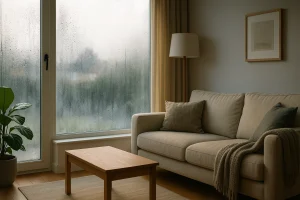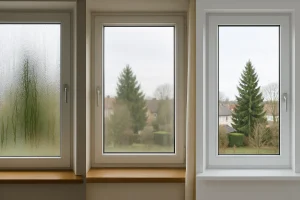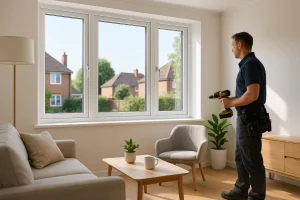Have you ever walked into your kitchen or bedroom on a chilly morning and found your windows misted up or dotted with water droplets on the inside? Why does this happen, and is it something to worry about? More importantly, can you prevent it without compromising on the warmth and comfort of your home?
Condensation on the inside of windows is a common occurrence in many UK homes, particularly in autumn and winter. While it may seem like a minor inconvenience, internal condensation can lead to structural issues, mould growth, and even health problems if not addressed properly.
In this comprehensive guide, we’ll answer the key questions about why windows condensate on the inside, explore the science behind it, and offer effective strategies tailored for the UK climate.
What Causes Windows to Condensate on the Inside?

Condensation forms when warm, moisture-rich air inside the home comes into contact with a cold surface, like a windowpane.
When this warm air cools down rapidly upon touching the colder glass, it can no longer hold all the moisture it contains. As a result, water vapour condenses into liquid droplets, which you see as fog or water on the glass.
This process is directly related to something called the dew point. The dew point is the temperature at which air becomes fully saturated with water vapour. Once a surface, such as your window, falls below this temperature, any moisture in the air begins to turn into liquid form.
This is why condensation on windows is more common during colder months when outside temperatures drop and windows become the coldest surfaces in the room. It’s the same principle behind seeing your breath in cold air or finding dew on the grass in the early morning.
How Does Indoor Humidity Contribute to Window Condensation?
Most homes naturally generate humidity through everyday activities. From boiling the kettle to taking a hot shower or even breathing, each of these actions releases moisture into the air. When this moisture has no way to escape, it begins to accumulate.
The warmer the air in your home, the more moisture it can hold. However, once it comes into contact with colder surfaces like poorly insulated windows, the excess moisture is released as condensation.
Modern UK homes are often built or renovated to be energy-efficient. While this improves insulation and helps reduce energy bills, it also limits natural airflow. Without sufficient ventilation, the moist air gets trapped inside, increasing the likelihood of internal window condensation.
Why Is Condensation More Noticeable During the Winter Months?
There are several reasons why condensation is worse during the colder seasons.
Firstly, as the temperature outside falls, the glass on the inside of your windows becomes much colder. Meanwhile, the interior of your home is kept warm with central heating. This contrast creates the perfect environment for condensation.
Secondly, during winter, windows and doors remain closed for longer periods, drastically reducing airflow. In older, draughtier houses, this was less of a problem, as the natural movement of air through chimneys and gaps helped to remove moist air. Modern properties are sealed more tightly, which traps moisture inside.
Also, activities like drying laundry indoors become more common in winter, adding even more humidity to the air. The combination of high indoor moisture levels, reduced ventilation, and cold surfaces explains the spike in condensation during this time.
Can Different Types of Windows Affect Condensation?

Yes, the type and condition of your windows have a significant impact on condensation levels.
Single-glazed windows are the most prone to condensation because there is no insulating barrier to keep the inner pane warm. The glass remains cold, even when the room is heated, which encourages condensation to form easily.
Older double-glazed windows can also be problematic if their seals have degraded. Once the seal is broken, moisture can enter the space between the panes, reducing the insulation properties and leading to condensation either inside or between the panes.
Modern energy-efficient double or triple glazing performs much better. These units are designed to retain more heat, keeping the internal glass pane warmer and reducing internal condensation.
However, these same highly insulated windows can experience external condensation a harmless form that occurs when the outer pane gets cold enough to fall below the dew point of outdoor air.
What Are the Risks of Ignoring Internal Window Condensation?
While occasional condensation might seem like nothing more than a visual annoyance, continuous or severe internal condensation can lead to multiple long-term issues in your home.
Prolonged damp conditions near windows can encourage black mould growth, particularly on walls, ceilings, window sills, and even curtains. This type of mould not only damages surfaces but can also lead to serious health problems.
According to the NHS, exposure to damp and mould increases the risk of respiratory infections, asthma, allergies, and can affect those with weakened immune systems more severely.
In addition to health concerns, moisture can damage your window frames, especially if they are wooden. Water can cause timber to swell, warp, or rot over time. Wallpaper may start to peel, and paint can blister or crack. In severe cases, moisture can penetrate plaster and even weaken structural elements of the building.
Are Some Rooms More Likely to Suffer From Window Condensation?
Certain areas in a house are more prone to internal condensation due to the way they are used and how much humidity they generate.
Bathrooms are high-risk zones because of frequent hot showers and baths. Without proper ventilation, steam quickly condenses on windows and tiles.
Kitchens also produce a lot of moisture from boiling water, cooking, and washing up. If extractor fans are not used or windows are kept shut, this moisture stays trapped inside.
Conservatories and orangeries often feature extensive glazing, making them more susceptible to internal condensation, especially in colder weather.
Unused bedrooms are another risk area. If heating is turned off and doors are kept closed, these rooms stay colder than the rest of the house. Moisture from surrounding areas may settle in these cooler zones, leading to hidden dampness and mould growth.
How Can You Prevent Windows From Condensating on the Inside?
The key to reducing or eliminating internal condensation lies in balancing humidity and ventilation. Below are the most effective methods:
Improve Ventilation

Even during winter, it’s important to let fresh air into your home. Open windows for a short period each day to allow moist indoor air to escape and fresh, drier air to enter.
For rooms with high humidity like kitchens and bathrooms, install or use existing extractor fans. Ensure they are used every time steam is produced, especially during cooking or bathing.
Ventilation can also be improved by using trickle vents on windows, air bricks, or mechanical ventilation systems like Positive Input Ventilation (PIV) units.
Increase Indoor Temperature Strategically
Maintaining a consistent indoor temperature can help prevent surfaces from cooling to dew point levels. Use radiators beneath windows to warm the glass and reduce condensation.
Rooms that are unused should not be completely shut off from heating. Install thermostatic radiator valves to maintain a mild, controlled temperature in those rooms to prevent cold spots.
Reduce Indoor Humidity
Simple lifestyle changes can significantly reduce moisture build-up. Avoid drying clothes indoors wherever possible. If you must, do it in a well-ventilated room or with a dehumidifier.
Always use lids when cooking and turn on extractor hoods or open a window. In bathrooms, close the door after a shower and open the window to prevent moisture from spreading.
Upgrade Your Windows

Replacing single-glazed windows with modern double or triple glazing is one of the most effective long-term solutions. It not only helps reduce condensation but also improves energy efficiency and comfort.
If you have old aluminium-framed windows, consider replacing them with versions that include a thermal break to minimise the transfer of cold temperatures from outside.
How Does External Condensation Differ from Internal?
External condensation may look similar, but it’s not a cause for concern. It forms when the outer pane of a high-performance double or triple glazed window is cooler than the surrounding air. As the humid outdoor air touches the cold surface, it condenses just like indoor air does on cold glass.
This is most likely to happen:
- On clear, still mornings when the sky has been cloudless overnight
- On east-facing windows which cool quickly
- In areas near rivers or open fields with high outdoor humidity
Fortunately, this type of condensation is temporary and typically evaporates as the day warms or wind picks up. It is often considered an indicator of how well-insulated your windows are.
What Does Condensation Between the Window Panes Indicate?
Seeing moisture trapped between the panes of a double-glazed unit is a sign that the seal has failed. When the airtight seal breaks, moisture from outside air can enter the insulating cavity.
In such cases, the insulation effectiveness is compromised, and the window becomes less energy efficient.
Unfortunately, the only real fix is to replace the sealed unit. In contrast, secondary glazing systems, which are not fully sealed, may experience occasional condensation in the cavity, which is normal and usually not problematic.
Internal vs External Condensation
| Type of Condensation | Where It Appears | Cause | Solution |
| Internal | Inside surface of the glass | Moist indoor air meeting cold surface | Improve ventilation, reduce humidity, increase room temperature |
| External | Outer pane of the glass | Cold outer glass and humid outdoor air | None required – disappears naturally |
| Between Panes | Inside double glazing unit | Seal failure | Replace the sealed unit |
Frequently Asked Questions
What are the signs of excessive indoor humidity?
Common signs include persistent condensation on windows, a musty smell, mould patches on walls or ceilings, and damp clothing or furniture.
Can keeping windows slightly open all the time help?
Yes, keeping a window slightly ajar or using trickle vents allows continuous airflow, which helps remove moisture-laden air from the room.
Are houseplants increasing my home’s humidity?
Yes, houseplants release water vapour through a process called transpiration. In large numbers or in small rooms, they can contribute to higher humidity.
Is it safe to use a dehumidifier overnight?
It is generally safe to run a dehumidifier overnight. Many modern units are energy-efficient and include timers or automatic shut-off features.
Should I replace all single-glazed windows to solve condensation?
While not always necessary, upgrading single-glazed windows to double or triple glazing significantly reduces the chance of internal condensation.
Will insulating curtains reduce condensation?
Insulating curtains keep warm air away from cold glass, which may slightly reduce condensation but can also trap moisture if not aired out regularly.
What’s the best humidity level to maintain indoors?
The ideal indoor humidity level is between 40% and 60%. You can use a hygrometer to monitor this.






